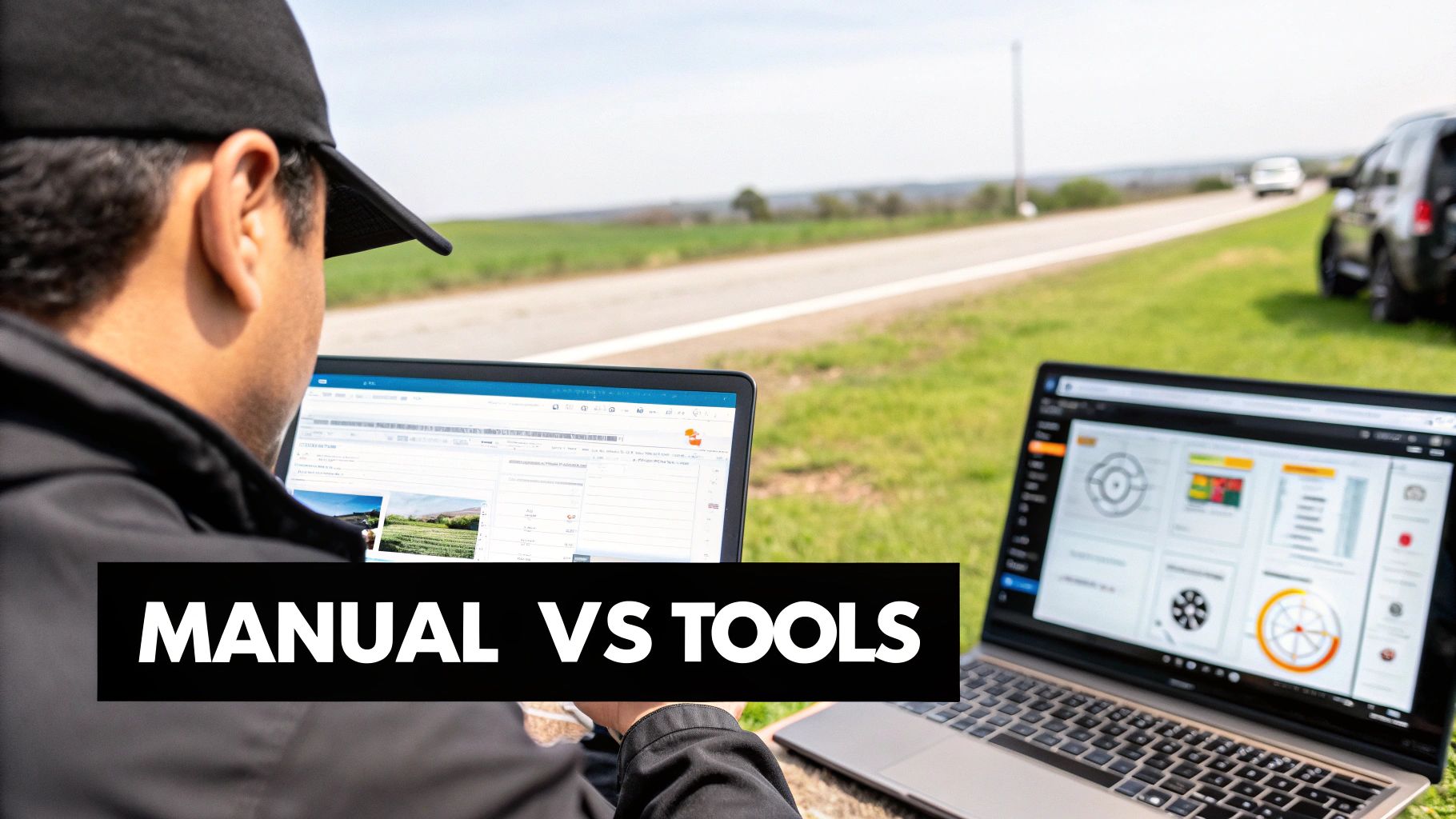To track SERP position effectively, you're not just glancing at Google every now and then. You're building a system to monitor your site's rankings for the keywords that actually matter to your business. This means moving from random checks to a consistent process—whether you do it by hand or use a specialized tool—to see exactly how your SEO work is paying off.
The entire point is to get data that actually informs your strategy, helping you react quickly to drops and jump on new opportunities.
Why Tracking SERP Position Is Non-Negotiable

Let's get past the idea that high rankings are just a nice-to-have. Think of SERP tracking as an early warning system for your website's health. It gives you a direct line of sight into your digital performance, turning abstract SEO efforts into concrete, measurable results.
Imagine a SaaS company sees a small slip from position #3 to #6 for a high-value keyword. Without regular tracking, that shift might go unnoticed for weeks. But by catching it early, they can dig in and find a technical SEO issue, like a broken redirect that's killing their authority.
They fix it right away, stopping a minor dip from turning into a major revenue loss. That's the real power of paying attention.
Safeguard Your Online Visibility
Tracking isn't about vanity. It's about protecting your online turf. Your SERP position is a direct reflection of how relevant and authoritative Google thinks your site is. A sudden drop is a red flag, pointing to potential problems:
- Algorithm Updates: Google is always tweaking things. Tracking tells you if a core update just knocked your site off its feet.
- Competitor Moves: Maybe a competitor just published an amazing piece of content or scored some powerful backlinks, pushing you down in the process.
- On-Site Technical Glitches: Things like crawl errors, slow page speed, or a terrible mobile experience can slowly chip away at your rankings.
By actively monitoring your position, you turn reactive panic into proactive strategy. You're not just watching numbers change; you're gathering the intelligence needed to defend your digital territory.
Prove the Value of Your SEO Efforts
SERP tracking is also your best friend when it comes to justifying your marketing spend. When you invest time and money into creating content, building links, or fixing technical issues, improved rankings are the most direct proof of success. This data is what connects your actions to real business outcomes.
Want to learn more? Check out our guide on how to measure marketing ROI.
The numbers don't lie. The #1 result on Google gets a massive 27.6% of all clicks. By the time you get to the second page, that number plummets to a tiny 0.63% CTR. This shows just how critical those top spots are.
At the end of the day, the goal of SEO for small businesses is to show up higher than the competition. Without tracking your SERP position, you’re just flying blind.
Choosing Your SERP Tracking Approach

When you decide it’s time to track SERP position, you’ll hit a fork in the road. One path is the old-school, do-it-yourself manual method. The other is the smarter, faster route paved with automated software.
Which one you pick will literally define the accuracy, efficiency, and depth of your entire SEO analysis. So, let's break it down.
The Problem With Manual Tracking
The manual route seems tempting at first. It's free, and the process feels simple enough: fire up an incognito browser, maybe use a VPN to spoof your location, and start typing your keywords into Google. You scroll, find your page, and jot its position down in a spreadsheet.
For a tiny handful of keywords, this is sort of manageable. But it quickly becomes a soul-crushing chore that’s dangerously unreliable.
Manual checks are what I call a false economy. Google's results are heavily personalized based on your search history, device, and exact location—even in incognito mode. This means the position you see is almost certainly not what your actual target audience sees, making your data flawed from the get-go.
Worse, this method gives you zero historical context. All you get is a single snapshot in time. You can’t spot a slow, creeping decline or pinpoint the exact day a competitor suddenly leapfrogged you. It’s like trying to understand a movie by looking at one still frame; you miss the entire story.
Without historical data, you're not tracking trends; you're just collecting isolated data points. This makes it impossible to connect your SEO actions to ranking outcomes or diagnose performance issues effectively.
The Power of Automated SERP Tracking Tools
This is where dedicated SERP tracking tools completely change the game. These platforms are built to eliminate all the guesswork and manual labor. They use non-personalized, geo-specific servers to check your rankings, giving you a true, unbiased picture of your visibility.
Automated tools bring advantages to the table that are just impossible to replicate by hand:
- Consistent Accuracy: They pull unbiased data from specific locations (down to the city level) and devices (desktop vs. mobile), which is critical.
- Historical Performance: Every single check is logged, creating a clean timeline of your rankings. You can instantly see your progress over weeks, months, or even years.
- Competitor Insights: You can track your rivals' positions for the exact same keywords, revealing their strategies and uncovering your best opportunities.
- SERP Feature Monitoring: Modern tools don't just track blue links. They monitor your presence in valuable SERP features like Featured Snippets, People Also Ask, and Local Packs.
The right decision really depends on your scale. If you're a local barber tracking just 3 keywords, a quick manual check might suffice for a casual glance. But for any serious SEO campaign, an automated tool isn't a luxury—it’s a non-negotiable necessity for reliable data and strategic decision-making.
Choosing between manual tracking and an automated tool can feel like comparing a flip phone to a smartphone. Sure, they both make calls, but one gives you an entire ecosystem of data, efficiency, and insights that the other simply can't match. To make it crystal clear, here’s a direct comparison.
Manual vs Automated SERP Tracking Comparison
As you can see, while manual tracking costs nothing upfront, the hidden costs in time, inaccuracy, and missed opportunities are enormous. An automated tool is an investment that pays for itself by providing the reliable data you need to make smart, impactful SEO decisions.
Setting Up Your First Tracking Project

Alright, enough with the theory. This is where the rubber meets the road. Kicking off your first project to track SERP position is exciting, but a sloppy setup will bury you in noisy, useless data. Getting it right from the start is the only way to get clean, actionable insights.
Think of it like building a house. A solid foundation—thoughtful keyword selection and precise configuration—means your entire SEO measurement strategy will be stable. Mess it up, and you’ll spend months chasing phantom ranking drops and celebrating meaningless gains.
Choosing Your Core Keywords
The keywords you decide to track are the lifeblood of your entire project. The rookie mistake? Dumping in a massive list of high-volume, generic terms and calling it a day. That’s a recipe for chaos.
A much smarter approach is to build a balanced portfolio of keywords that reflect the real-world customer journey.
Your initial list should be a strategic mix:
- Commercial Keywords: These are your money-makers. Think "B2B SaaS accounting software" or "project management tool for startups." They scream purchase intent and are non-negotiable for measuring bottom-of-funnel impact.
- Informational Keywords: This is your content marketing pulse check. Terms like "how to improve team collaboration" or "best way to track expenses" pull people in much earlier. Tracking these tells you if your blog is actually doing its job.
- Branded Keywords: This is your own name and your product names. Sure, you probably rank #1, but you need to monitor these. It's the quickest way to spot brand reputation problems or catch a competitor sneakily bidding on your name.
Organizing these before you even add them to a tool will make your life infinitely easier down the line.
Configuring Your Project for Accuracy
Got your keyword list? Great. Now for the configuration. This isn’t just ticking boxes; these settings determine whether your data reflects reality or a fantasy. Get it wrong, and you might be high-fiving a #1 spot in Dallas that doesn't even exist for your real audience in New York.
Inside your tool, nail down these settings:
- Search Engine and Location: Be specific. Choose the right Google database (like
google.comfor the US orgoogle.co.ukfor the UK). If you're a local business, you need to go deeper—get down to the city or even postal code. Hyper-local accuracy is key. - Device Type: You have to track desktop and mobile separately. No excuses. Rankings can be wildly different, and with over 60% of searches happening on mobile, ignoring it means you're flying blind.
- Competitors: Add your top three to five direct competitors. This one move transforms your tracker from a vanity dashboard into a competitive intelligence weapon. Seeing their rank shifts next to yours gives you context for every single fluctuation. For an even deeper look, some of the best competitor analysis tools can really level up your game here.
Remember, the goal is to mirror the exact search environment of your ideal customer. Every setting should be chosen with that user in mind to ensure the SERP data you collect is a true reflection of your visibility.
Finally, a pro tip: use tags from day one. Group keywords by product line (“Collaboration Suite”), funnel stage (“Top of Funnel”), or a campaign initiative (“Q3 Content Push”). This simple habit turns a flat, overwhelming list of keywords into a dynamic dashboard that actually tells a story.
Turning SERP Data Into Actionable Insights

Alright, your dashboard is live and data is pouring in. This is where most people kick back and watch the numbers. But honestly, the real work is just getting started.
Raw data is just noise. The whole point is to turn those numbers into a smart, strategic response that actually moves the needle.
Knowing you jumped from position #7 to #5 isn't the insight. The real win is figuring out why it happened so you can do it again. That means you have to get past a surface-level glance and start thinking like a detective.
Interpreting Key Ranking Metrics
Your SERP tracking tool is going to throw a few core metrics at you. The first step is to really get what each one is telling you without getting bogged down in the details.
- Position Changes: This is your instant feedback loop. Are you seeing a steady climb for a group of related keywords? Or did a bunch of rankings just nosedive, signaling a fire you need to put out?
- Visibility Score: Usually a percentage, this metric rolls up your performance across all your keywords into one number. I like to think of it as a stock market index for your site’s SEO health—it’s a quick, powerful snapshot of your overall progress.
- Estimated Traffic: This is where rankings meet reality. It gives you a rough idea of the clicks you’re getting from your current positions, helping you zero in on the keywords that will actually drive valuable traffic.
These metrics aren't islands; they tell a story together. For instance, a rising visibility score is awesome, but if your estimated traffic is flat, it probably means your gains are coming from keywords nobody is searching for.
From Data Points to Diagnosis
Let's play out a scenario I’ve seen a hundred times. You log in, grab your coffee, and see that a whole cluster of your most important money-making keywords has dropped five spots overnight. The gut reaction is panic. Don't do it.
This is your cue to put on the detective hat. Don’t just start randomly changing things on your site. Instead, run through a checklist to figure out what actually happened.
A sudden drop in rankings isn't a failure; it's a critical data point. It's the search engine giving you direct, albeit painful, feedback. Your job is to listen, diagnose the root cause, and formulate a precise response.
Here’s a simple diagnostic workflow to follow:
- Check for Algorithm Updates: Was there a confirmed Google update? Sometimes, you’re just collateral damage in a major algorithm shift that’s shaking up the entire industry.
- Audit Your On-Page Elements: Did anything change on the pages that dropped? A recent content tweak, an accidental "noindex" tag, or even a change in your internal linking can be the culprit. I’ve seen it happen.
- Analyze Your Competitors: This is huge. Look at who took your spot. Did they just drop a 10,000-word ultimate guide? Did they overhaul their page for a better user experience? Or did they just land a few killer backlinks?
When a competitor leaps over you for a keyword you both want, it’s a gift. Their page is a roadmap. Deconstruct what they did—their content structure, their backlink profile, their page speed. The answer to getting your spot back is often hiding right there in their strategy.
This is where historical data becomes your best friend. It lets you look back in time to spot trends and figure out what went wrong. For example, some tools let you see SEO ranking data going back years, showing you old ranks, clicks, and position changes. That context is gold for diagnosing drops and finding old strategies that worked—so you can use them again. You can see some great examples of this by exploring the SEO ranking history on SpyFu.com.
Advanced Strategies for SERP Dominance
Okay, you've got the basics down. You know how to track your keywords and see your position climb. But true SERP dominance isn't just about inching up from position three to two.
It's about owning the entire page.
Experienced SEOs have moved past just chasing the traditional blue links. They know the real prize is the valuable real estate that Google puts around those links. We're talking about Featured Snippets, the Local Pack, and the "People Also Ask" boxes.
Winning a spot in one of these features can be more powerful than a standard #1 ranking. Why? Because they grab a user's attention first, often answering their question directly and instantly positioning you as the authority. Tracking your presence here isn't just a nice-to-have; it's the next critical step.
Competitive Benchmarking as a Weapon
Here’s a powerful tactic I use all the time: turn your SERP tracker into a competitive intelligence tool. Don’t just watch your own keywords. Set up a dedicated project to track serp position changes for your top two or three rivals.
Think of it as a live feed of their strategic moves.
When you see a competitor suddenly leap up the rankings for a high-value keyword, that's a signal. It's your cue to dig in. Analyze their page and figure out what they did. Did they completely overhaul their content? Snag a few powerful new backlinks? This is how you find gaps in their strategy and exploit them before they dig in.
This kind of proactive monitoring is essential. In fact, over 70% of SEO practitioners are in their rank checkers daily, keeping tabs on these shifts. With Google commanding a jaw-dropping 90.38% of the global search market, you can't afford to look away.
Connecting SERP Data to Business Outcomes
At the end of the day, rankings are just a number. The ultimate goal is to connect those numbers to real business results. The best SEOs I know have integrated their SERP tracking data directly with tools like Google Analytics.
This is where the magic happens. You can finally draw a straight line from a ranking increase to a tangible boost in organic traffic, conversions, and revenue.
By linking SERP data with analytics, you stop reporting on vanity metrics and start demonstrating real business impact. You can confidently say, "Our effort to improve this keyword cluster's ranking led to a 15% increase in qualified leads last quarter."
To get to this level of insight, you need a rock-solid foundation in SEO principles. A great place to start is by understanding the core factors for improving search engine rankings.
